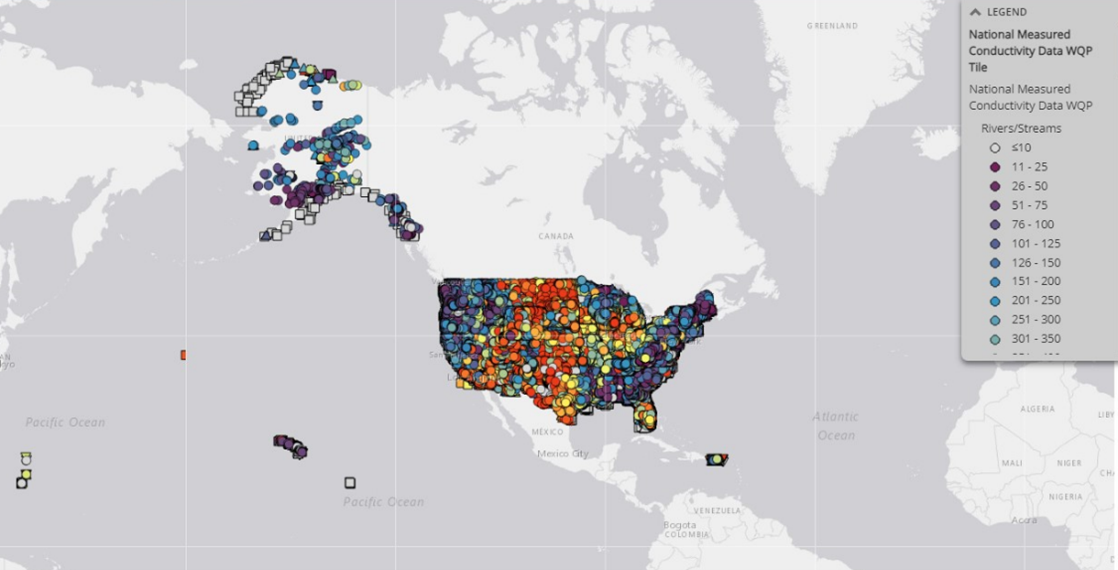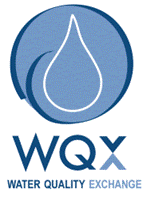WQX3.0 Data Now Available on the Water Quality Portal
WQX3.0 data are available through the Water Quality Portal. This updated version of the schema includes new elements and new profiles with updated column names.
What's on this page
The Water Quality Portal (WQP) is the largest publicly available water quality data warehouse in the United States. It integrates publicly available data from many providers and outputs those data in a common format, known as the Water Quality Exchange (WQX) standard. Today, it contains hundreds of millions of water quality records from over 2 million locations. Visualizations such as Figure 1 can help to show the distribution of these records across the nation. Hundreds of organizations – including multiple federal agencies, every state and territory, many Tribal Nations, and community science groups – are currently sharing their water quality data with others through the WQP. This important data warehouse integrates and serves diverse physical, chemical, and biological water quality data (observations, measurements, and samples) in a very detailed and common format. The standard used to describe these data has been updated to a new version, WQX3.0. This data exchange standard supersedes prior versions (WQX1.0, WQX2.0, WQX2.1, and WQX2.2).

Figure 1: Map of United States showing locations of conductivity data sampling locations as shown on EPA’s Freshwater Explorer in December, 2023.
How is this different from what you delivered before?

WQX3.0 is the newest version of the data standard that is delivered from the WQP (read more ). This version of the data standard was built upon the recommendation of the user community and offers more metadata elements than ever before. The standard can be viewed in full at this site . Some examples of new elements that are available in the WQX 3.0 version of the standard include:
- Drainage area measure: the dimension of the drainage basin of a lake, stream, wetland, or estuary site
- National aquifer code: A code that designates the principal aquifer associated with groundwater
- Biological habitat collection effort: the number of individuals or equipment deployed to collect the sample
- Laboratory comment text: remarks which further describe the laboratory procedures which produced the result
- Monitoring Location Tribal Land Indicator: An indicator denoting whether the location is on a tribal land
- Record Identifier User Supplied: The user supplied record identifier that is uniquely associated with data entered
- Activity Identifier User Supplied: User supplied designator that uniquely identifies an activity within an organization
WQX 3.0 is backwards-compatible with prior versions of the WQX standard, meaning that data submitted with an earlier version of the standard will still be served to users.
Where will I see these new data elements?
The WQX3.0 standard will soon be the default for data delivery out of the WQP. Until we fully switch to these profiles, we have set up a temporary user interface to serve these data. The temporary, or beta, user interface will deliver new WQX3.0 elements through newly configured data profiles. We will continue adding profiles and other enhancements to this beta site in coming weeks. Please check back regularly for improvements. While we are testing this beta release, our legacy user interface will continue to serve WQX2.2 profiles.
After the beta user interface has been tested, WQX3.0 data will become the default output that is accessible on our main user interface. This output will also be available via web services, and in downstream products such as USGS’s dataRetrieval R Package and EPA’s TADA R Package . There are new data profile (bundled data and metadata) options that are available to serve these new data; these data profiles were developed with the help of the WQP’s user community. The new data profiles are described here .
How do I update my workflow from WQX2.2 to WQX3.0?
The WQP’s beta user interface and web service URL generator will only include the WQX 3.0 profiles. If you use the WQP’s legacy user interface to retrieve WQP data, then you can use the beta user interface to generate your queries as you did before to access the new 3.0 profiles. If you leverage the WQP web services directly in your workflows, taking advantage of the enhanced metadata available in these new profiles will require changing those previously established workflows to use the new WQP 3.0 web services.
Column names have changed so they are easier to understand and use; if you switch to the new profiles you may need to update any scripts or workflows to accommodate these. We recommend migrating workflows to the WQX3.0 profiles as they become available so that you are consuming all supporting metadata. A helpful tool for this transition is our WQX3.0 Outbound Schema , which describes our fields and how these column names are different between versions of the schema.
One other important improvement with the release of the WQX3.0 profiles is the improved mapping of USGS data to the WQX standard. USGS data are now more fully mapped to the WQX3.0 standard, making their data more interoperable with other data in the Water Quality Portal. Along with this enhancement, USGS released several features that serve their data in the WQX standard and help users to migrate between the prior format and this new outbound format.
Will the previous WQX2.2 data profiles still be available?
The previous WQX2.2 data profiles will continue to work and existing web applications calling the WQP for WQX2.2 data will continue to operate; however, these profiles don’t offer as much metadata as the new profiles. Furthermore, USGS data that was collected or analyzed after March 11, 2024, as well as any modification to existing data made after this date will not appear in the WQX2.2 profiles. Therefore, it is recommended that users switch to the WQX3.0 profiles as they become available. For users who need time to transition to the WQX3.0 profiles, our web services page provides information about how to generate a web services request for prior versions of the WQX profiles. WQX2.2 data profiles and web services will remain available for a period of time, then they will be deprecated.
I have a current tool I’ve built on WQP datasets. Will I need update my workflow from 2.2 to 3.0.?
If you want to take advantage of the new 3.0 profile fields, then YES. Whether exploring data by column name or number, you should expect changes that will require you to update any operations looking for certain fields/fieldnames. We created mapping files
to enable mapping of the WQX2.2 outbound field names to the WQX3.0 outbound schema.
If you are a user of dataRetrieval, you will need to update your workflows as well. Our team is working to update the dataRetrieval package; users can learn about the status of updates by visiting the dataRetrieval status page
to best understand how to update their workflows.
Community Development of WQX3.0
The WQP is developed with input from its users and a unique community of ‘super users’, called the WQX User Community. This group helped to develop the 3.0 version of the WQX standard and also shaped the new data profiles. We are grateful to each and every participant of this group for contributing their time and expertise.
Feedback
Our development team wants to hear your thoughts and questions about these changes. Please let us know your thoughts on the new profiles, column names, and user interface. Your feedback is helpful and appreciated. Please send your questions and comments to wqx@epa.gov .
Related Posts
A tool to aid in the transition from the legacy NWIS discrete data format to the WQX format
September 15, 2024
Overview
Recently, the USGS modernized the format of its discrete water quality and sample data from a USGS-specific output format to the internationally recognized Water Quality Exchange (WQX) standard (for more background, read this blog post). Over many years, users have come to rely on USGS data from the NWIS
qwwebpage in a particular format for ongoing reporting and data analysis. Making the switch to a new format can be challenging, and we want to support users during this transition period. This blog post describes a resource (spreadsheet ) to help users access and use USGS discrete data in their existing workflows as they transition from legacy to modernized services.Accessing discrete water quality and sample data on WDFN
March 19, 2024
Introduction
We are excited to share with you some updates to how USGS discrete (occurring as separate and distinct events) water quality and field sample (a.k.a. ‘samples’) data can be viewed and downloaded from the Water Data for the Nation (WDFN) website. This is the third blog in a series describing the updates to public samples data delivery. Our first installment briefly introduces the changes, and the second installment provides background on the new data delivery standard, called the Water Quality Exchange (WQX) standard. In summary, this post:
How the USGS uses the WQX standard
December 27, 2023
Overview
- The Water Quality Exchange (WQX) standard is an internationally recognized data standard that makes it easier to share and use water quality data
- The USGS is expanding its current use of the WQX standard from a relatively coarse mapping for data delivered on the Water Quality Portal (WQP) to a comprehensive mapping of USGS sample data on both the WQP and the modernized USGS data portal, Water Data For the Nation (WDFN)
- Overall, USGS metadata will be more visible to users and it will be human-readable
What is WQX?
The WQX schema is a standardized data exchange format specifically for sharing water quality observational data. This data standard was developed by the Environmental Protection Agency (EPA) in conjunction with the US Geological Survey and other partner environmental organizations. The WQX schema provides a set of metadata attributes that are foundational for understanding ambient water quality observations. Users can define information about who collected samples and where, results and metadata about samples, and information that helps to contextualize results, such as habitat assessment scores and metrics.
Improved Public Delivery of Water Quality and Field Samples Data
August 24, 2023
What are sample data?
Sample data are derived from manual field collection and laboratory analyses, including for water quality, sediment, biological, air and soil samples (waterdata.usgs.gov/nwis/qwdata ). Sample data do not include data collected by continuously-measuring instruments, data from models, or simulated data.
Summer 2024 Impacts to WaterServices
July 3, 2024
WaterServices databases are receiving a major version update to meet security and dependency requirements. Beginning August 5, 2024, mandatory database updates will begin, and the following WaterService format return types will be permanently discontinued:

